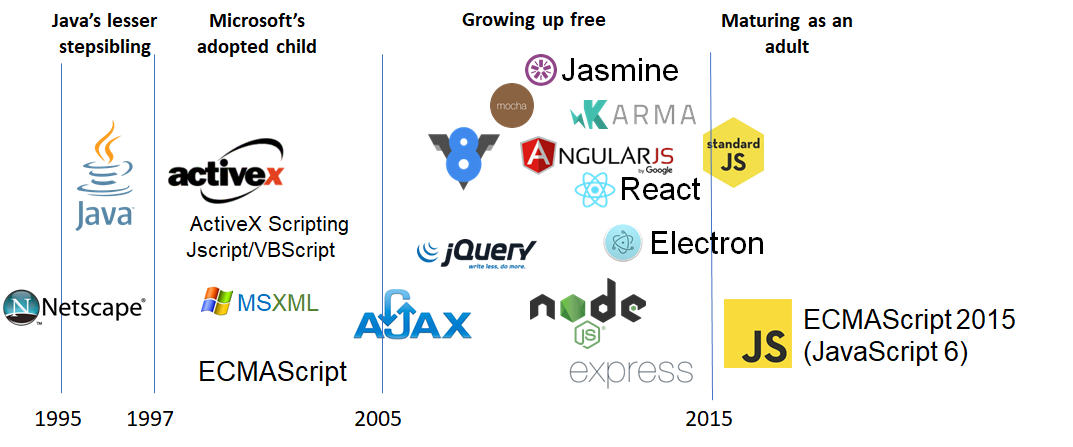The many lives of JavaScript
July 1, 2017


I recently worked out that I’ve learned, on average, a new programming language every two to three years. These many languages have been part of my toolbox for somewhere between four to six years before falling away to make room for new technologies. However, there is one programming language that has been a major part of my programming repertoire for almost 22 years now – and that is JavaScript.
My JavaScript programming skills have recently undergone a major renaissance as I’ve adopted JavaScript 6 (aka ECMAScript 2015), for most of my coding. The way I write code today is nothing like the code I wrote just one year ago – and I’ve gone back and largely modernised all active code to be consistent. Today’s programming style uses modern frameworks and is far more object oriented and asynchronous. There are many new features which have totally updated how I write code. Proper (while still limited) classes with mixins have replaced the ugly prototype mechanism I used to use for object orientation. Let and const declarations have caught latent bugs that were hidden in my code. Arrow functions (aka. lambda expressions) and promises have streamlined code that once was quite clunky. The list goes on…
Even my tools have changed. Microsoft’s surprisingly excellent Visual Studio Code has replaced the hodgepodge of tools I once used. We’re in the process of integrating Jasmine and Karma to the process. JavaScript Semistandard Style (no, I still like semicolons) has ensured a very clean code base – as well as catching a multitude of errors and sins.

All this change got me thinking about the four lives of JavaScript that I have worked through. Way back when, JavaScript had an awkward birth at the hands of Netscape as the lesser stepchild of the new Java programming language from Sun that was taking away all the attention. JavaScript was just a way to glue Java applets together in the browser. The problem is, Java applets really sucked.
Microsoft quickly saw the value of JavaScript though, and launched their own effort to steal Netscape’s baby. And so, JavaScript was stolen, renamed JScript and made to be the adopted sibling of Microsoft’s other scripting language, VBScript. One good bit progress that Microsoft made was to sponsor the standardisation of the language, although the resulting name of ECMAScript was another in a long string of unfortunate names the language has had to endure.
As JScript, JavaScript was to become an integral part of Microsoft’s entire ActiveX strategy. A lot of really cool technologies (yes, really) came of this allowing JScript to go beyond the browser. As an application extension language, it found its way into the XMetaL XML editor as the customisation technology. We used it and many of the ActiveX technologies to great effect when we implemented California’s bill drafting system. However, it didn’t just end there. We were able to use it on the server-side through Classic ASP and as a shell scripting language through the Windows Script Host. For a Microsoft-centric programmer, this era of JavaScript was a glorious one.
However, ActiveX was seriously flawed. It was entirely proprietary and riddled with problems. Microsoft abandoned it almost as quickly as they had adopted it – moving on to .Net where JScript.net was a non-starter. As Microsoft’s interest in ActiveX and even Internet Explorer waned in the early 2000s, life as a JavaScript programmer became ever gloomier. While the capabilities were awesome, there was obviously no future.
At this point, we made the somewhat painful decision to move away from Microsoft’s outmoded view of the Internet and go back to the basics. While it meant giving up a lot of capability, in the end it was an excellent decision for it pointed to the future. One tiny aspect of Microsoft’s ActiveX vision, the XMLHttpRequest object, escaped from Microsoft and gave rise to a whole different way of programming – Asynchronous JavaScript and XML (AJAX). This development and the emergence of new browsers, first Firefox and then Google’s Chrome with its V8 JavaScript engine, breathed new life into JavaScript.
Freed from Microsoft’s grip, JavaScript has flourished. The past decade has seen a plethora of new technologies. Isomorphic JavaScript (or Universal JavaScript) blurs the distinction between coding for the server and the client. In fact, technologies like Electron turn web-based application development back to the desktop where you can get the best of both worlds.
When I look back on the code I wrote during the ActiveX era (yes, we still support it), it looks prehistoric. Modern JavaScript is so much more capable and flexible than the clunky rendition we had back when COM-based ActiveX was supposed to change the world. As I mentioned earlier, how I program now is completely different – asynchronous programming is a difficult but very worthwhile skill to acquire.
Looking to the future, I see three paths. On one side is a mature but polarising platform that is dominated by Oracle. Oracle’s dominance ensures stability but also deters innovation. Looking to the other side, one finds another mature but polarising platform that is dominated by Microsoft. Here too, Microsoft’s dominance ensures stability but also deters innovation. The result is that it seems that both paths have now had their heyday. You don’t hear very much aspirational news from either technology path anymore — what it must have felt like programming a mainframe in COBOL at the height of the C/C++ era.
The third path seems to be the path of the future – staking out a middle ground that neither technology giant can stomp on. Sure, Google is a technology giant that plays a strong role, but they’re still reasonably well regarded by the development community at large (for now). It is this middle ground that has been the most fertile for new technologies – and JavaScript is right in the thick of it. There are so many new technologies it’s hard to keep track of them all — AngularJS, Node.js, React, Express.js, to name but a few. While this third path can play well with both of the other two, for me it is the path that truly points to the future.
This brings us to the fourth life for JavaScript – building on the momentum of the past decade to mount a credible challenge for enterprise apps. While I initially dismissed many of the new features of the language as mere syntactic sugar, my experience with it has shown it to be more. I now write much better code. I believe we’re on the verge of an explosion in JavaScript-enabled applications that will blur the distinction between the platforms, between the desktop and the browser, and between the server and the client. This is truly an exciting time, once more, to be developing in JavaScript.
It goes without saying, but stay tuned for more…








